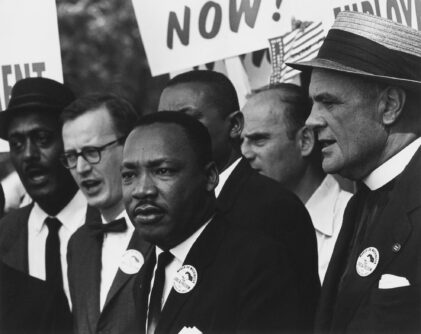Women’s economic mobility is increasing, and philanthropists can play an integral role in removing further barriers to their workplace success.
As detailed in a new report from the Independent Women’s Forum, “Working for Women 3.0: A Modern Agenda to Help Women Strive and Thrive,” policies abound that expand opportunities for women by encouraging the creation of a more dynamic, innovative and flexible working world.
While these policies are heading in the right direction, there continue to be barriers to women’s advancement like outdated degree requirements, underemployment, unnecessary occupational licenses and gender quotas that do more harm than good.
Women’s History Month gives us the opportunity to examine the barriers that continue to hinder women’s career advancement, but also to discuss the unique role philanthropy can play in moving women up the economic ladder.
Women’s Advancement
Nearly half of U.S. workers today are women. Over the past 70 years, the share of working men and women in the labor force has narrowed from a gap of 42 percentage points to just six percentage points. One out of three workers in the 10 highest-paying occupations are women—up from just 13% in 1980. Last year, a third of all S&P 500 board directors were women.
There are 14 million women-owned businesses in the U.S. They comprise 39% of all businesses—a 13.6% increase from 2019 to 2023 alone. A significant majority of women-owned businesses are one-woman shops. However, overall, women-owned businesses employ nearly 10% of the U.S. workforce.
Another important contribution to women’s workforce participation has been increased flexibility. During the pandemic, which forced many women out of traditional jobs to oversee their children’s online educations or care for family members, remote work and flexible scheduling expanded significantly for many workers.
Consequently, we’ve seen a tremendous increase in women freelancing, becoming self-employed or starting side businesses. Women now comprise nearly half of the nation’s 70-plus million freelancers. They choose to be independent for the flexibility, fulfillment and other benefits that traditional employment does not confer.
While women have made tremendous strides, there is undoubtedly much more for women to accomplish in the workforce. Women lag behind men in many other high-paying careers and leadership roles. For example, only 10% of Fortune 500 companies have female CEOs.
Gender Diversity Quotas
To propel women’s advancement in board and leadership roles, gender diversity initiatives are pushed as an ideal based upon the belief that greater diversity leads to more debate and better decision-making. That is true when diversity is broadly defined to include viewpoint, experience, socio-economic background and other categories, not narrowly limited to just gender and race. The data are actually mixed on the impact of demographic board diversity on corporate performance.
Women’s representation on boards and in leadership roles in companies and organizations is often used as a measure of societal progress, but in some cases good intentions do more harm than good. For example, the presence of one female board member has led some companies to feel the gender diversity box is checked, and no other women are needed, undermining the goal of seating the most qualified individuals.
Some believe women must achieve parity in all areas, but that misses the tradeoffs men and women make to achieve the lives they desire. The responsibility of raising families or caring for aging parents may deter some women from pursuing high-paying careers with demanding hours or leadership career tracks that require heavy business travel. Measured by the variety of opportunities women can choose from to carve out the best life for their situations, we are moving in the right direction.
Board representation is also not the best measure of progress if it undermines mission, organizational effectiveness and donor intent. For example, an organization serving vulnerable boys may lack gender diversity but could still be advancing its mission effectively. Should it be forced to add a woman for the sake of checking a box?
Consequently, government mandates to force gender and race diversity on boards are not just ill-advised but, as California has learned, illegal and discriminatory. Companies and organizations are embracing women in leadership because they are right for the job. The government should not tamper with what is working.
That is why the True Diversity campaign is as important as ever. Grantmakers and charities benefit from the tools to push back on demands for demographic box-checking.
How Donors Can Expand Opportunities by Removing Barriers
While pushing for greater economic mobility for women is still a valid goal, we must recognize that not all women are in the same position and find ways to meet them where they are.
Some barriers include underemployment, which is remarkably high for women who relocate frequently, such as military spouses. Immigrants and women with criminal records are often locked out of occupations and entrepreneurship by government policies. These are areas where, by supporting public policy advocacy, donors can expand economic mobility for many women.
Because not every woman desires a four-year degree, we must first remove degree requirements for millions of the nation’s middle-skill occupations. Increasingly, a high school diploma and even hands-on experience and skills are not enough for workers to secure jobs. At the same time, employers say degrees do not ensure better-qualified candidates. Thankfully, organizations and companies have begun to shift from requiring four-year degrees to skills-based hiring.
Donors can support educational and advocacy organizations that are pushing state and federal policymakers to implement assessments of all job positions and eliminate college degree requirements that are not relevant to the jobs. A dozen states—both red and blue—have removed degree requirements for thousands of state jobs, but many more should. Organizations such as Opportunity at Work and the Cicero Institute are at the forefront of driving policy changes to unlock middle-skilled jobs for the 70 million workers who do not have a degree.
Second, by reforming or removing unnecessary occupational licenses, many women will be able to engage in jobs they have been locked out of. Over the past 60 years, the number of occupations requiring licensure has skyrocketed from just one in 20 workers in the 1950s to more than one in four today.
Licenses are state government-issued permission slips to work. The required education and training can create barriers to opportunity for individuals who cannot afford it. There is often no health or safety rationale for the licenses. Because each state has its own requirements, which vary by occupation, people who move frequently, such as military spouses, find it difficult to maintain their credentials and stay employed.
Some states even outlaw those with a criminal record from obtaining a license, which undermines reentry efforts. Immigrants with unique skills and experience from their homelands find excessive licensure unwelcoming, inhibiting their ability to work.
States are exploring regional compacts and agreements to accept licenses. They are also reducing or eliminating occupational licenses. Organizations such as the Institute for Justice fight for women such as hair braiders and eyebrow threaders while advocating for policy changes that will free millions of women to pursue their ambitions.
Women’s progress is undeniable, and philanthropy can be a supportive force in removing the barriers to their continued achievement.
Learn more about True Diversity and how the Roundtable advances pathways to opportunity.
Originally published at Philanthropy Roundtable on March 27, 2024, at www.philanthropyroundtable.org/advancing-working-women-for-greater-mobility.






